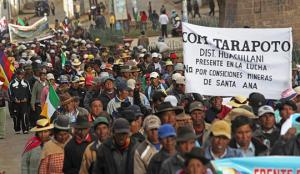Indigenous anti-mining protesters in southeastern Perú have agreed to temporarily suspend their mobilizations until after the run-off presidential vote scheduled for Sunday, June 5.
For the past three weeks, up to 30,000 Aymará and Quechua farmers have organized road blockades that paralyzed commerce at the Perú-Bolivian border and shut down the regional capital city of Puno.  The protesters want the Peruvian government to revoke the Santa Ana silver mining concession granted to Canada’s Bear Creek Mining Company, which they say will pollute Lake Titicaca and nearby rivers, undermining the local farm and fishing economy. They are also demanding a halt to future extraction projects in the region.
The protesters want the Peruvian government to revoke the Santa Ana silver mining concession granted to Canada’s Bear Creek Mining Company, which they say will pollute Lake Titicaca and nearby rivers, undermining the local farm and fishing economy. They are also demanding a halt to future extraction projects in the region.
At the height of the protests, 600 trucks were trapped on the Bolivian side of the border, mostly carrying food exports to Peruvian ports (since Bolivia lacks its own seacoast), along with 200 on the Peruvian side. Some 300 foreign tourists were stranded, along with thousands of local residents who work on either side of the normally fluid international frontier.
Neighborhood groups fed and sheltered truckers, commuters, and protesters alike until their supplies ran out. Bolivian campesinos, in an act of solidarity, expanded the blockade on the Bolivian side.
According to Epifanio Baca, a Peruvian economist, the protest reflects a growing opposition to outgoing president Alan García’s policy of granting generous mining concessions with no local or community consultation. Last month, the government was forced to suspend the Tia Maria copper mining project in Arequipa after 3 protesters were killed in clashes with police.
Perú’s recent mining boom, spurred by a surge in global commodity prices, has led to a tripling of mining concessions in the mineral-rich Puno region since 2002. Yet Puno’s mostly indigenous population, with a regional poverty rate exceeding 60%, has experienced few of the benefits.
Up to this point, the protesters have successfully exploited opportunities created by the upcoming presidential election, a closely contested race between left-leaning Ollanta Humala and ultra-conservative Keiko Fujimori which has riveted international attention—with García, a powerful force in Peruvian politics, still calling the shots behind the scenes.
Rather than risk police violence which could produce a sympathy vote for Humala, García opted not to forcibly remove or repress the demonstrators—even when government buildings were sacked (an action the protesters blame on provocateurs). Faced with the embarrassment of a potential vote disruption in Puno, García also agreed to several demands made by local authorities—including a requirement for Bear Creek to consult with the community and a one-year suspension of mining concessions in several provinces—which the protesters rejected as insufficient.
The protesters’ decision to halt the mobilizations in order to allow the regional vote to proceed would appear to benefit Humala, who has strong support in Puno, where he launched his election campaign last year. Yet Humala—now desperately seeking support from the electoral center--has not endorsed the “no-mining” agenda, calling instead for a tax on windfall mining profits. Both candidates have urged Garcia to negotiate a settlement.
The protesters have vowed to return to the barricades next Tuesday if their demands are not satisfied. Whether they can retain their current leverage after the election remains to be seen.
(video credit: Al Jazeera English)

